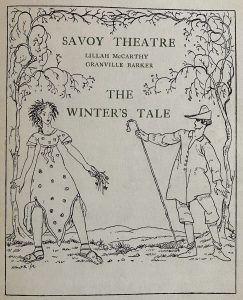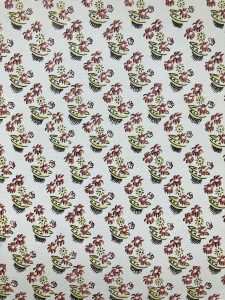Background
Albert Rutherston was a good friend of Silvia’s, as far back as her acting days, before WW1. She writes, in Journey to Yesterday, that they met as a result of a poster Rutherston created for Harley Granville Barker’s influential production of A Winter’s Tale in 1912 . Silvia was so impressed by the poster that she wanted to meet the artist and asked a mutual friend, Hugo Rumbold, to arrange an introduction.
Albert was born in Bradford on 15th December 1881, the youngest of six children. His father, Moritz Rothenstein, worked in the wool business and was married to Bertha; they were both of German Jewish descent. In 1916, as a sign of patriotism, Albert and his eldest brother (Charles) changed their surname to Rutherston.
He attended Bradford Grammar School before following in the footsteps of another brother, William, and enrolled at the Slade School of Art in London in 1898. There he formed a strong relationship with Augustus John and William Orpen; they were affectionately known as The Three Musketeers. William went on to serve as a War Artist in both World Wars and became Principal of the Royal academy of Art.
Rutherston’s early paintings were traditional landscapes and portraits of domestic life. In 1905 he became a member of the New England Art Club and in 1910 held his first solo exhibition. At this point, he turned to decorative work, notably designing theatre costumes & sets and later illustrating books. His importance as an illustrator was his use of pen work and original use of print blocks. His drawings have a whimsical and light touch with delicate colour shading.
In the early days of WW1, Albert prepared (or delivered) a lecture, entitled ‘Decoration in the Art of the Theatre’. It was due for presentation at Leeds University in February 1915. Subsequently, it was edited by Harold Munro and published in August 1919 by the London based Poetry Bookshop. Rutherston used the opportunity to argue for theatre decoration to be considered as important as all the other aspects of theatre production, rather than it being treated as a minor discipline.
He also designed posters for the London Underground during the mid-1920s. From 1929-48 he was appointed Ruskin Master of Drawing at the art school founded by John Ruskin in Oxford in 1871. For several years he lived in Bisley, a village near Stroud, Gloucestershire.
He died in Switzerland on 14th July 1953.
CORRESPONDENCE
Albert’s drawings are delightful but his hand writing is famously illegible – a magnifying glass is needed to decipher the text! There is minimal punctuation and, likewise, few paragraphs; an occasional sketch is interspersed, sometimes mid-sentence.
A – World War 1
Albert served in the Army from 1916-1919. He sent three letters to Silvia during this period. They are held in the Beinecke Library.
The first was written on a Thursday (probably 1916) when he was based in Ryde, on the Isle of Wight, awaiting duty orders for service abroad. He is ‘horribly bored’ and suggests Silvia finds a friend with whom she might travel to the Island for a rest. It includes a sketch of a bulky man, with a serious bespectacled face and folded arms; it is tagged ‘vile young Hindenberg’ who at the time was a field marshal in charge of the Imperial German Army.
The second letter is written in Palestine ‘camped in the wilds of the Judean mountains’ and dated 7th January. Albert is delighted to have received a letter and news from Silvia. He seems to be busy and content, in spite of constant rain and mud, as well as hyenas and jackals wandering around at night. He sketches a picture of himself leaning on a stick, dressed in a thick army coat and knee-high boots.
The third letter is sent from Ward 13, Eastern General Hospital, Cambridge and is dated Sunday 21st January 1917. He is languishing in hospital because of an injured knee and is very bored but hopes to leave within a fortnight. There is a sketch of him walking with sticks and a heavily bandaged knee.
In all three letters Rutherston makes mention of Julian, an actor friend / boyfriend of Silvia’s. In the first two he asks after Hugo & the Baroness – this most likely refers to their mutual friend Hugo Rumbold whose mother was a Baroness and widowed in 1913. Likewise, Enid (Bagnold) features, plus a few miscellaneous friends but not ones we know of through Silvia’s books or correspondence.
B – Engagement, New Year 1933
On learning about Silvia’s engagement to Athole, Albert sent special letters, plus sketches, to each of them. A description of how these letters were discovered appears in the Engagement section of the Marriage page. Here are short extracts from both letters.
New Years Day 1933
Dearest and best of Silvias – All our warmest and most delighted wishes
to you & Athole. I can’t tell you how overjoyed we are
to get your letter. If anybody in my world deserves happiness, it
is, dear Silvia, yourself and now one is certain that in
Athole you will find it – and he, lucky fellow, in you.
2 January 1933
My Dear Athole – what a lovely New Year it is for you.
A Time … to offer every warmest congratulations… that
you have found a wonderful happiness….. (all her friends)
must share the very real joy that we do in the knowledge that
she & you have found each other. It is quite splendid.
C – Post 1933
In correspondence with the Hodgsons, Silvia provides regular updates of their various friends, including news of Albert and his family.
PUBLISHERS
Below is a list of some of the Publishers with whom Rutherston worked as an illustrator after WW1:
Sign of the Flying Fame – Poetry & Chapbooks; founded by Claud Lovat Fraser, Holbrook Jackson and Ralph Hodgson
Curwen Press – Patterned papers for book covers
Ernest Benn – Shakespeare plays
Chatto & Windus – Almanacks
The Nonesuch Press – Anthologies
Kynoch Press – Calendars
Limited Editions Club – Shakespeare plays
Details of Publishers have been extracted from Ian Rogerson’s Pen, Paper & a Box of Paints – as are the two images below. On the left is the Programme cover for The Winter’s Tale (p41). On the right is the book cover; it is a copy of one of Rutherston’s patterned papers, made for Curwen Press in 1927. It also features in Rogerson’s book (p173).


Sources:
Pen, Paper & a Box of Paints by Ian Rogerson; Fleece Press, Upper Denby (2015)
Silvia Baker Papers: General Collection, Beinecke Rare Book and Manuscript Library, Yale University (Norman Holmes Collection)
© Rutherston Family (WW1 correspondence)
